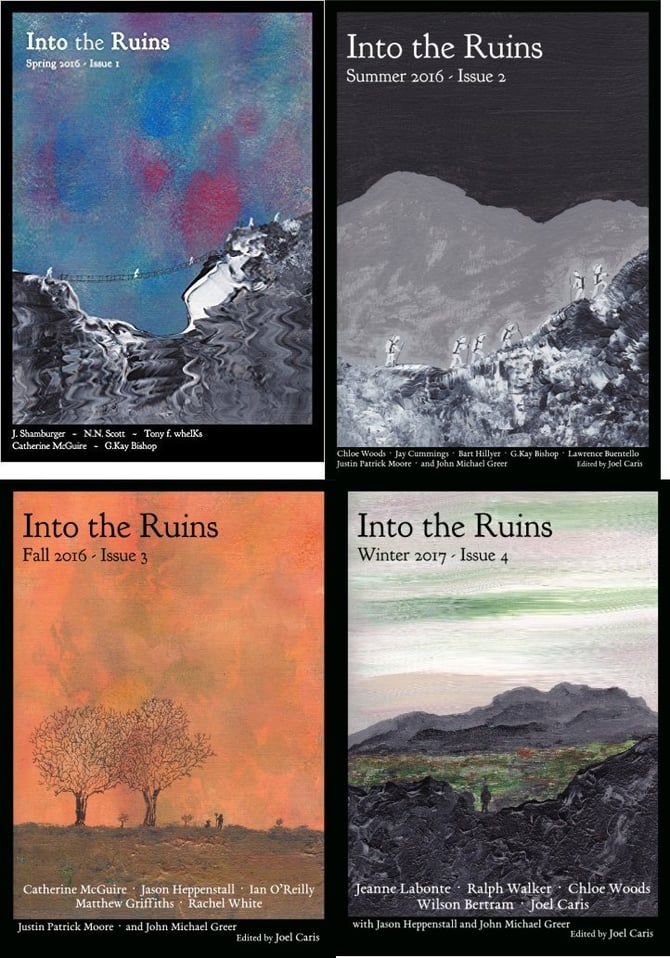
Into the Ruins: Year One (Issues #1-4)
Discover the entire first year of Into the Ruins with this Year One introductory package. For the discounted price of just $25, you get the first, second, third, and fourth issues as high quality digital PDFs. This package includes nearly 450 pages of great content, including twenty fantastic stories of deindustrial science fiction, multiple book reviews, a wide variety of letters to the editor, four unique Editor’s Introductions, and more.
This is the perfect way to introduce yourself to the fascinating and entertaining genre of deindustrial science fiction. Pair this with the Year Two package to discover all that Into the Ruins has to offer.
The issues included and their descriptions are:
Spring 2016 (Issue #1)
Inside these pages are visions of a deindustrial future. These stories are a different way of understanding our future, devoid of spaceships and interstellar travel and instead focusing on a future defined by natural limits, energy and resource depletion, industrial decline, climate change, and other consequences stemming from the reckless and shortsighted exploitation of our planet. These are imaginings of the ways that humans will adapt, survive, live, die, and thrive within this future. From a civilization 1,500 years from now whose religions stem from the Principia Discordia and a worship of commerce, to agricultural societies dealing with climate change and chaos, to ritualistic death by rising sea and the struggles of a small town doctor, these stories take a hard look at the destructive ways in which we are currently treating our ecosystems, consider the inevitable consequences, and map out the likely futures we are making for ourselves. The results, rooted firm right here on Earth, are fascinating and compelling.
Summer 2016 (Issue #2)
In the second issue of Into the Ruins, we continue to explore the emerging sub-genre of deindustrial science fiction. John Michael Greer debuts a new column on the sub-genre while five new and compelling stories weave future scenarios devoid of spaceships and interstellar space travel and instead focus on a future defined by natural limits, energy and resource depletion, industrial decline, climate change, and other consequences stemming from the reckless and shortsighted exploitation of our planet—and the ways humans will adapt, survive, live, die, and thrive within such a future.
These stories show a wide variety of possible futures for humanity, from a distant civilization that cycles through the same ebb and flow of peace and warfare we find littered throughout human history, to a melancholic meditation on our fast-changing world set in 2020 that feels eerily familiar to today; from a love story set in a less energy-intensive time, to a haunting encampment at the edge of dry and dusty ruins; and on again to an adventurous and amusing attempt to deliver a key new manuscript on the herbal treatment of spinal meningitis to a distant library. These stories inspire a wide range of emotions, from meditative reflection on the predicament of our times to delight at unexpected adventure—all while offering readers fascinating tales utterly different than what science fiction normally provides.
Fall 2016 (Issue #3)
In the second issue of Into the Ruins, we continue to explore the emerging sub-genre of deindustrial science fiction. John Michael Greer debuts a new column on the sub-genre while five new and compelling stories weave future scenarios devoid of spaceships and interstellar space travel and instead focus on a future defined by natural limits, energy and resource depletion, industrial decline, climate change, and other consequences stemming from the reckless and shortsighted exploitation of our planet—and the ways humans will adapt, survive, live, die, and thrive within such a future.
These stories show a wide variety of possible futures for humanity, from a distant civilization that cycles through the same ebb and flow of peace and warfare we find littered throughout human history, to a melancholic meditation on our fast-changing world set in 2020 that feels eerily familiar to today; from a love story set in a less energy-intensive time, to a haunting encampment at the edge of dry and dusty ruins; and on again to an adventurous and amusing attempt to deliver a key new manuscript on the herbal treatment of spinal meningitis to a distant library. These stories inspire a wide range of emotions, from meditative reflection on the predicament of our times to delight at unexpected adventure—all while offering readers fascinating tales utterly different than what science fiction normally provides.
Winter 2017 (Issue #4)
In the second issue of Into the Ruins, we continue to explore the emerging sub-genre of deindustrial science fiction. John Michael Greer debuts a new column on the sub-genre while five new and compelling stories weave future scenarios devoid of spaceships and interstellar space travel and instead focus on a future defined by natural limits, energy and resource depletion, industrial decline, climate change, and other consequences stemming from the reckless and shortsighted exploitation of our planet—and the ways humans will adapt, survive, live, die, and thrive within such a future.
These stories show a wide variety of possible futures for humanity, from a distant civilization that cycles through the same ebb and flow of peace and warfare we find littered throughout human history, to a melancholic meditation on our fast-changing world set in 2020 that feels eerily familiar to today; from a love story set in a less energy-intensive time, to a haunting encampment at the edge of dry and dusty ruins; and on again to an adventurous and amusing attempt to deliver a key new manuscript on the herbal treatment of spinal meningitis to a distant library. These stories inspire a wide range of emotions, from meditative reflection on the predicament of our times to delight at unexpected adventure—all while offering readers fascinating tales utterly different than what science fiction normally provides.

